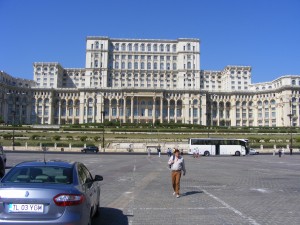Have moved to Bucharest today, where I will stay for a couple of days prior to going to Poland this Saturday.
Bucharest is a larger old European city. Many beautiful old buildings with the ornate baroque ornamentations, built in the 17- or 1800s. Unfortunately, mixed with these are the ugly slab-sided concrete structures too typical of the eastern European cities that were under the sway of communism. The style is jokingly referred to as “Stalinist gothic”. They were poorly built and are now festooned with air-conditioners, satellite dishes, laundry and decayed structure.
To continue with Romanian history from the previous blogs, under communism there were two premiers, with the second – Ceausescu – starting in 1966. Ceausescu borrowed a great deal of money to build up industry. The factories provided jobs but with central planning and without competition the products were generally of very poor quality. Large numbers of workers were moved from the rural to urban areas, hence the constructions mentioned in the previous paragraph.
By the early 1980s, Ceausescu decided to pay off his loans and become a banker rather than borrower. He also decided to build an immense “People’s Palace” to more centrally locate all the ministries. This took money, so salaries were decreased while electricity, heating fuel, food and everything else became rationed. Long lines for bread, should there be any left when you got to the front of the queue (a good Scrabble word for you!). Once classical communism hit the dustbin of history in 1989, his people rose in a massive spontaneous protest that was sustained long enough for the military to get the message and switch sides. Ceausescu fled but was caught and summarily executed.
Construction of the “People’s Palace” began in 1984 and was 70% finished when the revolution occurred. This building is huge – by area the world’s second largest (after the Pentagon) and by volume the third largest. I will try to include a picture but it does not include the whole building as I simply could not get far enough away to fit it in the viewfinder. The outside is of cement constructions and includes some baroque ornamentations though stylistically has little to commend it beyond immensity.
We took the tour inside. There are about twenty big (read: gargantuan) halls. In the largest, which had 2200 square meters and ceiling 16 m tall, I counted 28 chandeliers; he immense rug was woven on site as there was no way to make it elsewhere and bring it in. Lots of marble and wood, some rooms obviously influenced by the Peles Palace that I described a few days ago. More than a million square meters of marble, and similar amounts of wood, metal, crystal and so forth. Basically industry was told to provide this and that – at no cost of course as all industry was state-owned. The country was essentially bankrupted by this building, though it now is a tourist attraction, serves as something of a convention center and house of Parliament. Ceausescu is vilified and there is not representation of him in the building, or likely anywhere in Romania.
